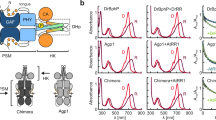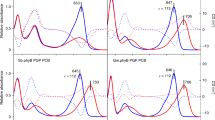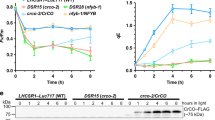Abstract
Plants use a set of light sensors to control their growth and development in response to changes in ambient light. In particular, phytochromes exert their regulatory activity by switching between a biologically inactive red-light-absorbing form (Pr) and an active far-red-light absorbing form (Pfr)1,2. Recently, biochemical and genetic studies have demonstrated the occurrence of phytochrome-like proteins in photosynthetic and non-photosynthetic bacteria3,4,5,6,7—but little is known about their functions. Here we report the discovery of a bacteriophytochrome located downstream from the photosynthesis gene cluster in a Bradyrhizobium strain symbiont of Aeschynomene. The synthesis of the complete photosynthetic apparatus is totally under the control of this bacteriophytochrome. A similar behaviour is observed for the closely related species Rhodopseudomonas palustris, but not for the more distant anoxygenic photosynthetic bacteria of the genus Rhodobacter, Rubrivivax or Rhodospirillum. Unlike other (bacterio)phytochromes, the carboxy-terminal domain of this bacteriophytochrome contains no histidine kinase features. This suggests a light signalling pathway involving direct protein–protein interaction with no phosphorelay cascade. This specific mechanism of regulation may represent an important ecological adaptation to optimize the plant–bacteria interaction.
This is a preview of subscription content, access via your institution
Access options
Subscribe to this journal
Receive 51 print issues and online access
$199.00 per year
only $3.90 per issue
Buy this article
- Purchase on Springer Link
- Instant access to full article PDF
Prices may be subject to local taxes which are calculated during checkout




Similar content being viewed by others
References
Quail, P. H. et al. Phytochromes: photosensory perception and signal transduction. Science 268, 675–680 (1995)
Smith, H. Phytochromes and light signal perception by plants—an emerging synthesis. Nature 407, 585–591 (2000)
Kehoe, D. M. & Grossman, A. R. Similarity of a chromatic adaptation sensor to phytochrome and ethylene receptors. Science 273, 1409–1412 (1996)
Hughes, J. et al. A prokaryotic phytochrome. Nature 386, 663 (1997)
Jiang, Z.-Y. et al. Bacterial photoreceptor with similarity to photoactive yellow protein and plant phytochromes. Science 285, 406–409 (1999)
Davis, S. J., Vener, A. V. & Vierstra, R. D. Bacteriophytochromes: phytochrome-like photoreceptors from nonphotosynthetic eubacteria. Science 286, 2517–2520 (1999)
Schmitz, O., Katayama, M., Williams, S. B., Kondo, T. & Golden, S. S. CikA, a bacteriophytochrome that resets the cyanobacterial circadian clock. Science 289, 765–768 (2000)
Giraud, E., Hannibal, L., Fardoux, J., Verméglio, A. & Dreyfus, B. Effect of Bradyrhizobium photosynthesis on stem nodulation of Aeschynomene sensitiva. Proc. Natl Acad. Sci. USA 97, 14795–14800 (2000)
Muratomo, T., Kohchi, T., Yokota, A., Hwang, I. & Goodman, H. M. The Arabidopsis photomorphogenesis mutant hy1 is deficient in phytochrome chromophore biosynthesis as a result of a mutation in a plastid heme oxygenase. Plant Cell 11, 335–347 (1999)
Parkinson, J. S. & Kofoid, E. C. Communications modules in bacterial signalling proteins. Annu. Rev. Genet. 26, 71–112 (1992)
Zhulin, I. B., Taylor, B. L. & Dixon, R. PAS domain S-boxes in Archaea, Bacteria and sensors for oxygen and redox. Trends Biochem. Sci. 22, 331–337 (1997)
Taylor, B. L. & Zhulin, I. B. PAS domains: Internal sensors of oxygen, redox potential, and light. Microbiol. Mol. Biol. Rev. 63, 479–506 (1999)
Ponnampalam, S. N., Buggy, J. J. & Bauer, C. E. Characterization of an aerobic repressor that coordinately regulates bacteriochlorophyll, carotenoid, and light harvesting-II expression in Rhodobacter capsulatus. J. Bacteriol. 177, 2990–2997 (1995)
Gomelsky, M. & Kaplan, S. Molecular genetic analysis suggesting interaction between AppA and PpsR in regulation of photosynthesis gene expression in Rhodobacter sphaeroides. J. Bacteriol. 179, 128–134 (1997)
Li, L. & Lagarias, J. C. Phytochrome assembly. J. Biol. Chem. 267, 19204–19210 (1992)
Bhoo, S.-H., Davis, S. J., Walker, J., Karniol, B. & Vierstra, R. D. Bacteriophytochromes are photochromic histidine kinases using a biliverdin chromophore. Nature 414, 776–779 (2001)
Fleischman, D. & Kramer, D. Photosynthetic rhizobia. Biochim. Biophys. Acta 1364, 17–36 (1998)
Clayton, R. K. The induced synthesis of catalase in Rhodopseudomonas sphaeroides. Biochim. Biophys. Acta 37, 503–512 (1960)
Kokotek, W. & Lotz, W. Construction of a lacZ-kanamycine–resistance cassette, useful for site-directed mutagenesis and as a promoter probe. Gene 84, 467–471 (1989)
Boivin, C., Camut, S., Malpica, C. A., Truchet, G. & Rosenberg, C. Rhizobium meliloti genes encoding catabolism of trigonelline are induced under symbiotic conditions. Plant Cell. 2, 1157–1170 (1990)
Yurkov, V., Schoepp, B. & Verméglio, A. Photoinduced electron transfer and cytochrome content in obligate aerobic phototrophic bacteria from genera Erythromicrobium, Sandaracinobacter, Erythromonas, Roseococcus and Erythrobacter. Photosynth. Res. 57, 117–128 (1998)
Quandt, J. & Hynes, M. F. Versatile suicide vectors which allow direct selection for gene replacement in gram-negative bacteria. Gene 127, 15–21 (1993)
Author information
Authors and Affiliations
Corresponding author
Ethics declarations
Competing interests
The authors declare that they have no competing financial interests.
Rights and permissions
About this article
Cite this article
Giraud, E., Fardoux, J., Fourrier, N. et al. Bacteriophytochrome controls photosystem synthesis in anoxygenic bacteria. Nature 417, 202–205 (2002). https://doi.org/10.1038/417202a
Received:
Accepted:
Issue Date:
DOI: https://doi.org/10.1038/417202a
This article is cited by
-
Optogenetic manipulation and photoacoustic imaging using a near-infrared transgenic mouse model
Nature Communications (2022)
-
A light life together: photosensing in the plant microbiota
Photochemical & Photobiological Sciences (2021)
-
Yeast engineered translucent cell wall to provide its endosymbiont cyanobacteria with light
Archives of Microbiology (2020)
-
System-level analysis of metabolic trade-offs during anaerobic photoheterotrophic growth in Rhodopseudomonas palustris
BMC Bioinformatics (2019)
-
Light on the cell cycle of the non-photosynthetic bacterium Ramlibacter tataouinensis
Scientific Reports (2019)
Comments
By submitting a comment you agree to abide by our Terms and Community Guidelines. If you find something abusive or that does not comply with our terms or guidelines please flag it as inappropriate.



